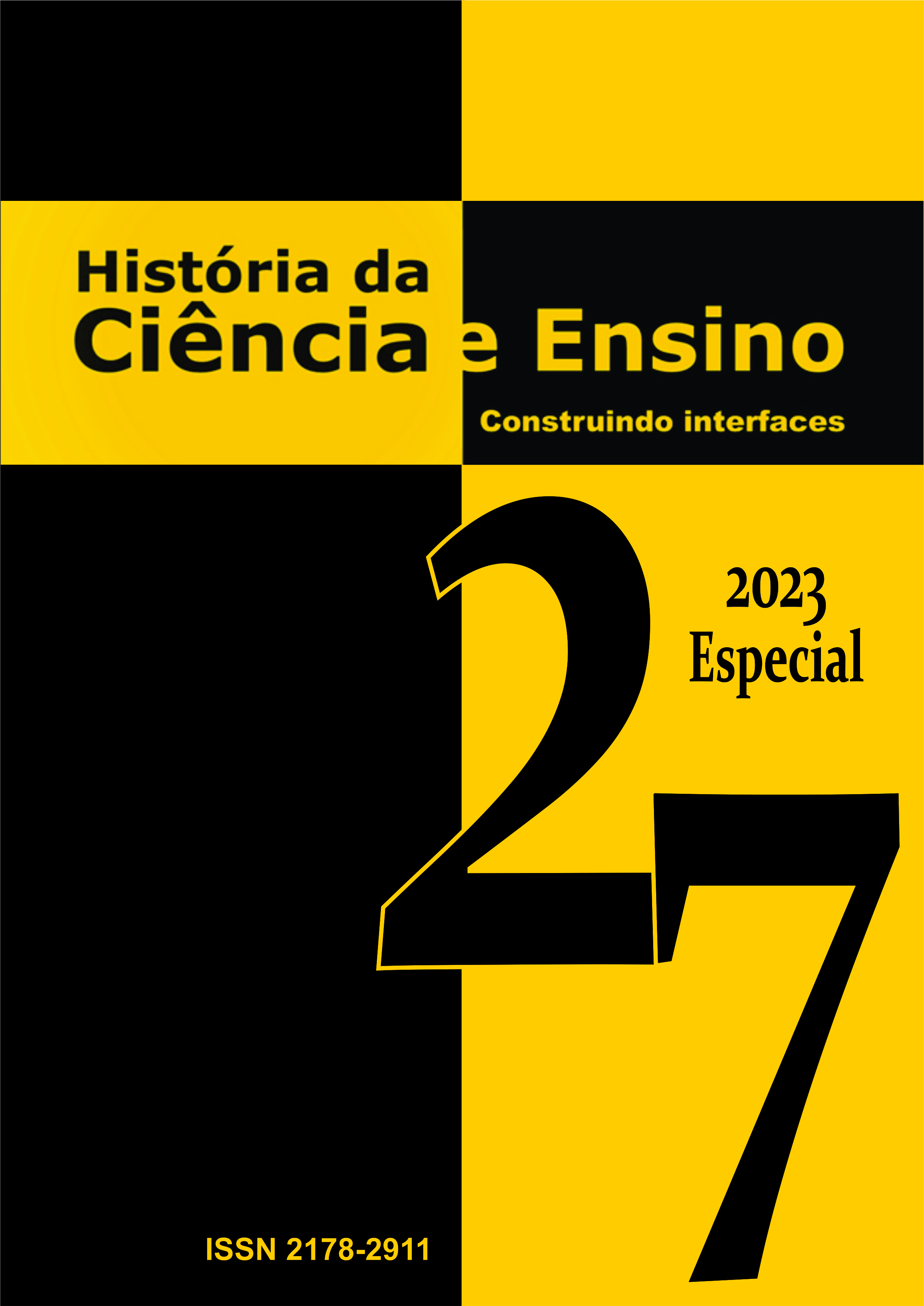Quando a Arte se Junta à História das Ciências: Newton, Goethe e Sugimoto
Newton, Goethe and Sugimoto
DOI:
https://doi.org/10.23925/2178-2911.2023v27espp51-66Palavras-chave:
prisma triangular, experiências do mundo, Spencer FinchResumo
Resumo
Neste trabalho, de natureza reflexiva, farei algumas incursões aos textos de Isaac Newton e de Johann W. von Goethe, sobre a origem das cores. Conhecendo o modo polémico de Goethe contra Newton, não pretendo opor ideias e experimentações destas duas personagens tão importantes e tão diferentes na forma de conhecer o mundo. As abordagens fenomenológicas de Goethe devem constituir-se como complemento importante quando nos interessamos por uma educação científica que nos ligue ao mundo e à fruição intelectual. Há artistas que ajudam a pressentir a importância das duas abordagens, expandindo horizontes e não retirando espessura ao mundo. Destacarei os trabalhos de Spencer Finch e de Hiroshi Sugimoto. A valorização pedagógica da história das ciências que tenho vindo a trabalhar, tem sido alimentada por alguns questionamentos que vou encontrando em escritos sobre arte. De onde vem esta forma especial e tão artificial como o é esta do prisma triangular e que atrai a atenção de Newton, num determinado momento? Como posso, por exemplo, alimentar o gosto de ter nas mãos este objeto? Agenciar com a arte, torna estes processos de conhecimento e de experiência mais estimulantes e significativos.
Palavras-chave: prisma triangular, experiências do mundo, Spencer Finch.
Abstract
In this work, of a reflective nature, I shall make some incursions into the texts of Isaac Newton and Johann W. von Goethe, on the origin of colors. Knowing Goethe's polemical approach to Newton, I do not intend to oppose the ideas and experiments of these two characters who are so important and so different in their way of knowing the world. Goethe's phenomenological approaches should be an important complement when we are interested in a scientific education that connects us to the world and intellectual enjoyment. There are artists who help to understand the importance of both approaches, expanding horizons and not taking away thickness from the world. I shall highlight the works of Spencer Finch and Hiroshi Sugimoto. The pedagogical appreciation of the history of sciences that I have been working on has been fueled by some questions that I find in writings about art. Where does this special and artificial shape like the triangular prism come from, which attracts Newton's attention at a certain moment? How can I enjoy and making others enjoy when holding this object in my in their hands? Working with art makes these knowledge and experimenting processes more stimulating and meaningful.
Keywords: triangular prism, experiences of the world, Spencer Finch.
Referências
Abbott, Berenice. Documenting Science. Göttingen: Steidl, 2012.
Cartwright, Nancy. The Dappled World. Cambridge: Cambridge University Press, 1999.
Debaise, Didier & Stengers, Isabelle (eds). Aux Risque des Effets, Une lute à main armée contre la Raison? Mayenne: Les Liens qui Libèrent, 2023.
Eckermann, Johann Peter. Conversations of Goethe. Londres: Da Capo Press, 1998.
Feingold, Mordechai. The Newtonian Moment – Isaac Newton and the Making of Modern Culture. New York, Oxford: The New York Public Library / Oxford University Press, 2004.
Gage, John. Color and Meaning: Art, Science and Symbolism. Berkeley, Los Angeles: University of California Press, 1999.
Goethe, Johann Wolfgang. Theory of Colours. Cambridge, Massachusetts e Londres: The MIT Press, 1997.
Goethe, Johann. Traité des Couleurs. Paris: Triades, 1993.
James, William. Conférences sur l’Éducation. Paris: L’Harmatan, 1996.
Newton, Isaac. Opticks. Nova Iorque: Dover Publications, Inc., 1979.
Newton, Isaac. A letter of sir Isaac Newton. Philosophical Transactions, 80 (19 de Fevereiro 1671): 3075-3087. https://royalsocietypublishing.org/doi/pdf/10.1098/rstl.1671.0072
Park, David. The Fire Within the Eye – a historical essay on the nature and meaning of light. Princeton, New Jersey: Princeton University Press, 1997.
Powers, Richard. Assombro. Queluz de Baixo: Editorial Presença, 2022.
Robbins, Brent. New Organs of Perception: Goethean Science as a Cultural Therapeutics. Janus Head. 8 (1, 2005): 113-126.
Sepper, Dennis. Goethe contra Newton. Cambridge: Cambridge University Press, 2002.
Silva, Cibelle & Martins, Roberto. A teoria das cores de newton: um exemplo do uso da história da ciência em sala de aula. Ciência & Educação. 9 (2003): 53-65. https://www.researchgate.net/publication/270485549_A_teoria_das_cores_de_newton_um_exemplo_do_uso_da_historia_da_ciencia_em_sala_de_aula/link/5904c8f44585152d2e93ef93/download
Whitehead, Alfred. The Aims of Education and Other Essays. New York: The Free Press, 1967.
Whitehead, Alfred. La Science et le Monde Moderne. Paris: Éditions du Rocher, 1994.
Nota: todos os endereços URL apresentados nas legendas das imagens de obras artísticas, ao longo do texto, foram testados durante alguns anos e permanecem válidos num último acesso realizado dia 5 de dezembro. Correspondem a ligações a galerias de arte e a sites dos próprios artistas.


